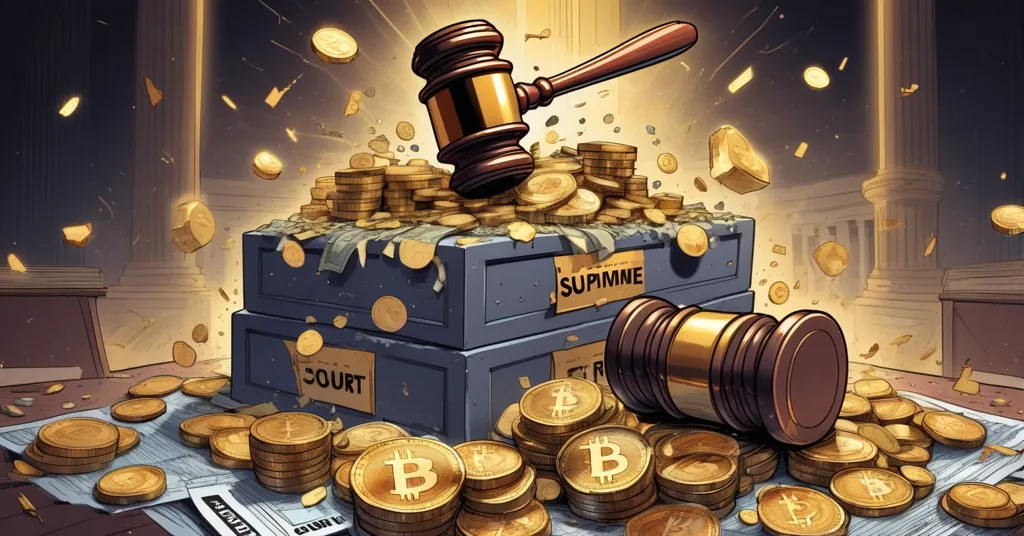Treasury Secretary Cuts Trump’s $2,000 Tariff Dividend: Bitcoin Impact Amid Supreme Court Clash

Treasury Secretary Scales Back Trump’s $2,000 Tariff Dividend: Bitcoin and Crypto Implications Amid Legal Battle
President Trump’s eye-catching pledge of a $2,000 “tariff dividend” for Americans has been dialed back by Treasury Secretary Scott Bessent, just as a Supreme Court showdown threatens to derail the entire tariff strategy. With legal and economic stakes soaring, this policy drama carries undercurrents that could ripple into the world of Bitcoin and decentralized finance.
- Dividend Reality Check: Bessent suggests the $2,000 benefit may not be cash but tax breaks.
- Legal Threat: Supreme Court case on November 5 could invalidate Trump’s tariffs, costing over $100 billion in refunds.
- Crypto Connection: Fiscal policy failures could boost Bitcoin’s appeal while tightening regulatory screws on crypto.
The Tariff Dividend: Promise vs. Reality
Trump made waves with a viral Truth Social post, promising a $2,000 payout to most Americans—excluding the ultra-wealthy—funded by revenue from tariffs on imported goods. It’s a populist pitch that frames tariffs as a dual win: protecting American jobs and putting cash directly into people’s pockets. But Treasury Secretary Scott Bessent, speaking on ABC’s This Week, poured cold water on the idea of literal checks arriving in the mail as detailed in a recent report on Bessent’s tempered expectations.
“There are lots of ways that $2,000 could show up.” – Scott Bessent
Instead of direct payments, Bessent hinted at indirect benefits through tax breaks—think exemptions on tips, overtime pay, or Social Security contributions, or even deductions on auto loans. This pivot reeks of political spin: repackaging existing or planned tax cuts as a shiny new “dividend” while dodging the logistical nightmare of actual payouts. For the average American hoping for a quick cash infusion, this clarification might feel like a bait-and-switch. Yet, if executed, these tax tweaks could still ease financial burdens for some—if the revenue to support them actually materializes.
What Are Tariffs, and Why Do They Matter?
For those new to the game, tariffs are taxes imposed on imported goods, meant to make foreign products more expensive and encourage consumers to buy domestic alternatives. Trump has long championed tariffs as a tool to shield American industries and reduce the U.S. trade deficit, which measures how much more we import than export. His latest move, the “Liberation Day” tariffs announced on April 2, slaps 10% to 50% taxes on most imports, with rates varying by country of origin. The goal? Generate massive revenue while leveling the playing field for U.S. businesses.
Bessent doubled down on this vision, projecting a financial windfall.
“Over the course of the next few years, we could take in trillions of dollars.” – Scott Bessent
He was quick to note, however, that the primary aim isn’t just cash but “fair trade.” The backdrop to this ambition is the jaw-dropping $37 trillion U.S. national debt—a figure so staggering it’s almost abstract. Trump and Bessent argue that tariff revenue could chip away at this burden while funding promises like the dividend. Sounds like a jackpot, right? Well, hold off on the confetti—consumers often end up paying the tab through higher prices at the checkout, and the projected trillions hinge on import volumes staying steady despite those price hikes. Historical trends suggest that’s a shaky bet, as people tend to buy less when costs soar.
Supreme Court Showdown: A Potential Game-Changer
Here’s where the plot thickens. On November 5, the Supreme Court took up a case that could blow Trump’s tariff strategy to smithereens. The core issue is whether Trump overstepped his authority by using emergency powers to impose tariffs on billions in imports. Emergency powers are typically reserved for genuine crises—think wars or natural disasters—not as a catch-all for reshaping trade policy. The U.S. Constitution explicitly grants Congress, not the president, the power to levy taxes, and tariffs are effectively a tax passed on to American businesses and consumers through pricier goods.
Chief Justice John Roberts laid bare the constitutional concern during the hearing.
“Imposing tariffs is like taxing Americans, and that power belongs to Congress, not the president.” – Chief Justice John Roberts
Strikingly, skepticism crossed ideological lines, with even Trump-appointed justices like Neil Gorsuch and Amy Coney Barrett joining liberal justices in questioning the legal footing of this policy. If the court rules against Trump—a decision potentially coming by mid-2025—the fallout could be monumental. Analysts estimate over $100 billion in refunds to companies that paid these duties, based on tariff collection data since their implementation. More than that, it would deal a severe blow to Trump’s executive leverage over trade, reshaping how far a president can stretch “emergency” justifications.
Constitutional law scholar Adam White didn’t hold back on the odds facing the administration.
“This case looks like a loss for the administration… an uphill climb from start to finish.” – Adam White
A loss here wouldn’t just unravel the “Liberation Day” tariffs; it could set a precedent curbing presidential overreach in economic policy for decades. But even if Trump prevails, tariffs aren’t the silver bullet they’re sold as. Take the 2018 steel and aluminum tariffs as a cautionary tale: they saved some jobs in those sectors but hammered downstream manufacturers—think companies making cars or appliances—who faced higher raw material costs. Those costs trickled down to consumers, offsetting any revenue gains with economic drag. A repeat on a larger scale risks igniting retaliatory trade wars, as seen historically with the Smoot-Hawley Tariff Act of 1930, which deepened the Great Depression. Supporters might argue tariffs protect domestic industries, but the collateral damage often outweighs the wins.
Tariffs and National Debt: A Crypto Perspective
Now, let’s zoom in on why this matters to the Bitcoin and crypto crowd. A government wrestling with a $37 trillion debt through blunt tools like tariffs is a government desperate for revenue—any revenue. When traditional fiscal policies falter or get mired in legal quicksand, regulators often turn their gaze to alternative financial systems. Crypto users, brace yourselves: if tariff income falls short, the IRS could ramp up efforts to track every Bitcoin transaction or DeFi yield farm. We’ve seen this before—after the 2008 financial crisis, tax enforcement tightened as governments scoured for cash. Expect harsher reporting rules, audits, or even bans on privacy tools like mixers, all packaged as ‘protecting the economy.’
This kind of fiat system pressure is precisely why Bitcoin’s value proposition burns brighter. Why anchor yourself to a currency devalued by endless printing and political missteps when you’ve got a decentralized, hard-capped asset like BTC? Bitcoin maximalists will argue it’s the ultimate escape hatch from fiscal incompetence—a currency immune to inflation by design. Look at past crises: during the 2020 COVID market crash, Bitcoin’s price spiked as trust in traditional systems wobbled. A tariff-fueled trade war or debt spiral could trigger a similar flight to financial sovereignty. If government overreach in trade policy signals tighter economic control, Bitcoin embodies the push for effective accelerationism—outracing bureaucracy with unstoppable tech.
But don’t sleep on the broader blockchain ecosystem. While Bitcoin doesn’t directly solve trade friction—and arguably shouldn’t—altcoins and protocols like Ethereum bring unique tools to the table. Imagine smart contracts automating tariff payments or enabling peer-to-peer trade deals, cutting through the red tape of traditional systems. Platforms like Polygon or Avalanche could power decentralized marketplaces where importers and exporters sidestep punitive taxes altogether. Dismissing altcoin utility in a tariff-heavy world is shortsighted; blockchain tech could emerge as a dark horse disruptor in cross-border commerce. Still, Bitcoin’s core promise of privacy and freedom remains unmatched when fiat systems teeter.
Here’s the harsh truth: regulatory landmines litter the path to mass adoption. A cash-strapped state is a nosy one, and if tariffs flop—or even if they succeed—the fallout could mean outright hostility to anything challenging centralized control. Post-2008 style crackdowns or new crypto tax grabs aren’t just possible; they’re probable. Bitcoin’s allure grows with every government stumble, but the fight for decentralized finance is far from over. This tariff saga might be a sideshow, but its implications for crypto are mainstage.
Key Takeaways and Burning Questions
- What is Trump’s $2,000 tariff dividend, really?
It’s a promised $2,000 benefit for most Americans, funded by tariff revenue, but Treasury Secretary Scott Bessent clarified it’s unlikely to be direct cash—instead, it could appear as tax breaks on tips, overtime, or Social Security. - Why is the Supreme Court scrutinizing Trump’s tariff policy?
The court is examining whether Trump’s use of emergency powers to impose tariffs is constitutional, since taxation, including tariffs, is a power reserved for Congress, not the president. - What’s at stake if Trump loses this legal fight?
A ruling against him could dismantle his tariff agenda, force over $100 billion in refunds to companies, and significantly curb presidential authority over trade policy. - Can tariffs realistically tackle the $37 trillion national debt?
Trump and Bessent claim tariffs could generate trillions, but critics highlight flaws in the math, pointing to higher consumer costs and potential trade wars that could negate benefits. - How does this impact Bitcoin and the crypto space?
Fiscal policy struggles could lead to tougher crypto regulations and tax enforcement, while reinforcing Bitcoin’s appeal as a fiat alternative and spotlighting blockchain’s potential for trade solutions.
Digging deeper, this tariff debacle lays bare the messy clash of policy, power, and economics. Trump’s gamble on trade barriers to fund populist promises like a $2,000 dividend is bold, borderline reckless, and now teeters on a judicial knife-edge. Bessent’s backpedaling hints the administration knows a direct cash payout might be dead on arrival, opting for tax tweaks that are easier to push but lack the same punch. Meanwhile, the Supreme Court’s looming verdict could redefine not just tariffs but the very limits of executive reach. For the crypto world, it’s a stark reminder of why decentralization matters. So, are tariffs a daring fix or a dangerous bluff? And does Bitcoin’s promise shine brighter with every government misstep? It’s a puzzle worth mulling over as this fiscal drama plays out.



